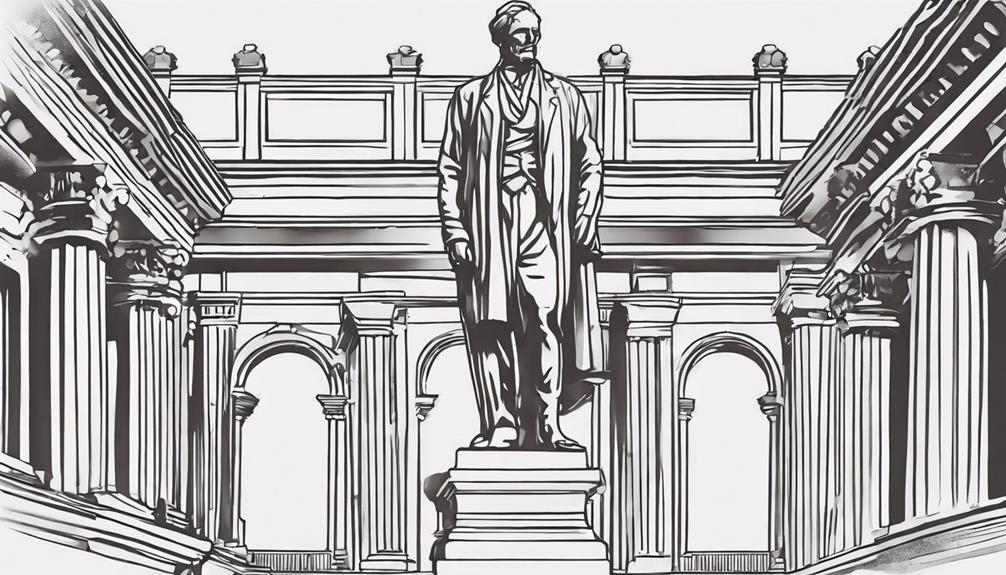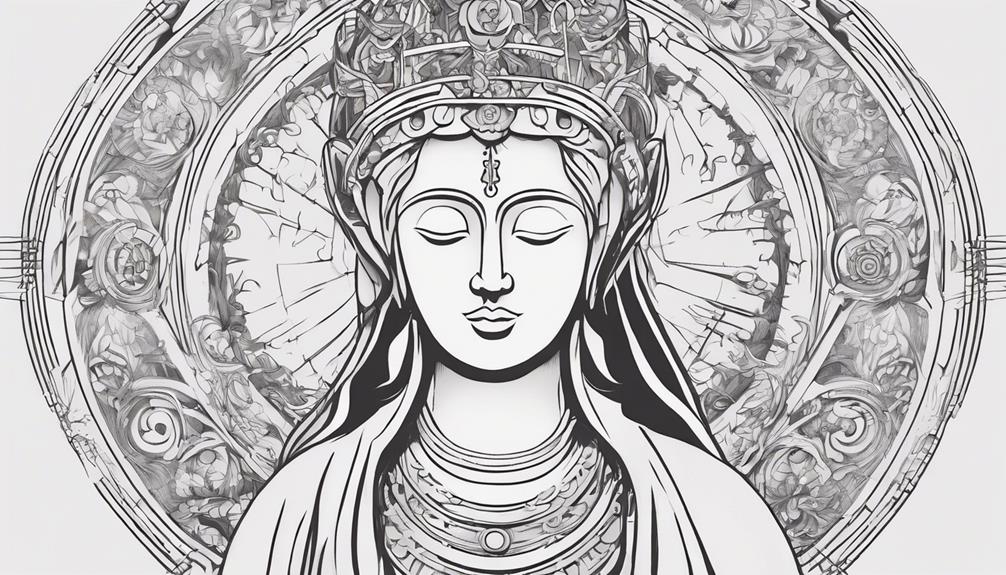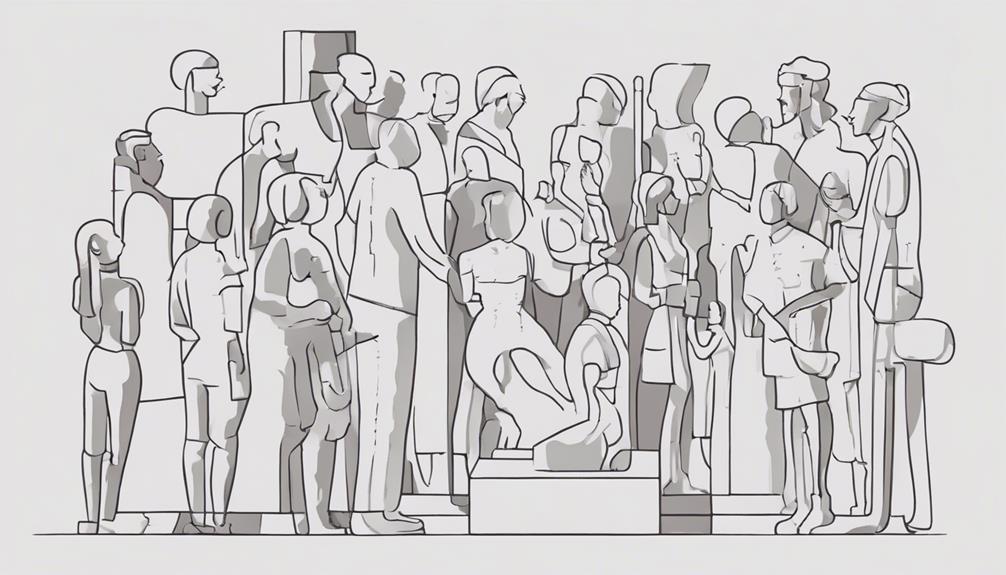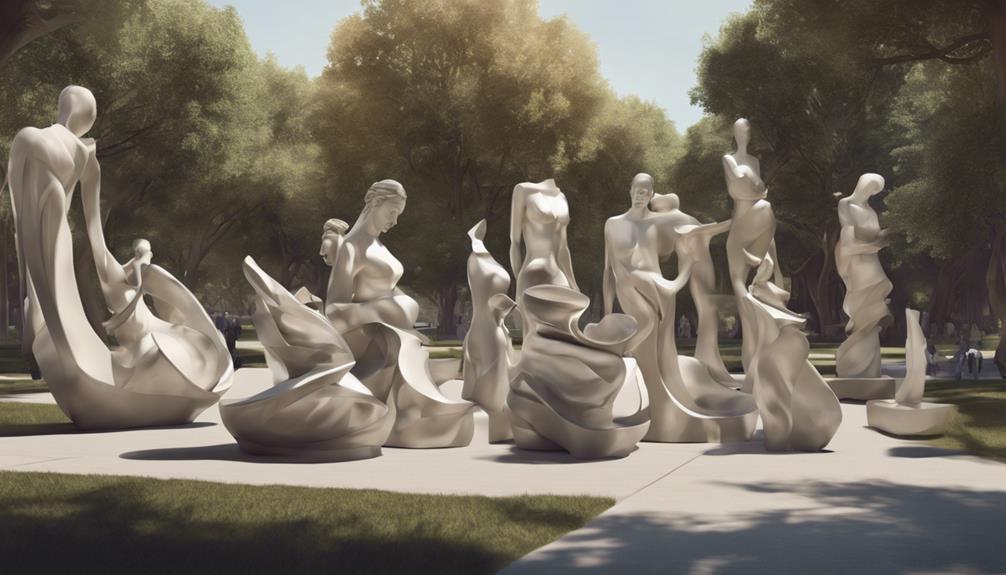Sculptures, as artistic manifestations through the ages, serve as more than mere aesthetic objects. The purpose of sculptures goes beyond their physical form, delving into the realms of history, culture, and human expression. From ancient civilizations to modern-day societies, sculptures have played a pivotal role in conveying stories, beliefs, and emotions. But what truly drives the creation of sculptures? What underlying motives push artists to mold raw materials into intricate forms that captivate our senses and spark our imagination? Let's explore the intricate tapestry of reasons that underpin the enduring legacy of sculptural art.
Key Takeaways
- Sculptures serve to immortalize historical figures and preserve cultural heritage.
- They convey complex ideas and narratives through symbolic representations.
- Sculptures depict religious beliefs, honoring deities and conveying spiritual significance.
- Cultural sculptures reflect societal values, norms, and artistic expressions, embodying historical narratives.
Historical Significance of Sculptures

Sculptures, bearing profound historical significance, have served as timeless vessels for conveying religious teachings, immortalizing prominent figures, and preserving cultural heritage. Dating back to ancient civilizations, sculptures have been a fundamental art form used by humans to depict their beliefs, values, and societal structures. In ancient times, sculptures were crafted using a variety of materials such as stone, clay, and metal, showcasing the skill and creativity of artists through intricate designs and lifelike representations of human forms.
These ancient sculptures not only showcased artistic prowess but also served practical purposes in society. They were used to honor and immortalize kings, queens, and pharaohs, preserving their legacy for future generations. Additionally, sculptures were utilized to convey religious stories, myths, and beliefs, acting as visual aids for teaching and transmitting cultural and spiritual knowledge. Through the art of sculpture, ancient civilizations were able to capture the essence of their time, reflecting societal norms, traditions, and historical events for posterity.
Symbolism in Sculptural Art
Symbolic representations in sculptural art play a pivotal role in conveying nuanced meanings and fostering profound connections between viewers and the artwork. Sculptures use symbolism to evoke emotions, provoke thoughts, and communicate complex ideas without words. By incorporating symbolic elements, artists can convey specific themes, concepts, or narratives to audiences, sparking reflection and contemplation. These symbolic representations in sculptures often symbolize various aspects of life, culture, and society, representing historical events, mythological stories, religious beliefs, or societal values through their symbolic forms.
| Symbolism in Sculptural Art | |
|---|---|
| Conveys nuanced meanings | Fosters profound connections |
| Evokes emotions | Provokes thoughts |
| Communicates complex ideas | Sparks reflection |
| Represents various aspects of life and society |
Religious Depictions in Sculptures

The artistic portrayal of religious figures and narratives through sculptural art has long served as a significant means of conveying spiritual beliefs and teachings. In ancient Greek mythology, sculptures of deities like God Zeus were prevalent, symbolizing power, wisdom, and authority. These sculptures not only represented the gods themselves but also carried religious messages and signified the importance of faith in ancient Greek society. The ancient Greeks used sculptures not only for artistic expression but also as a way to honor and worship their gods, emphasizing the religious significance of these artworks.
Furthermore, sculptures of religious figures in various cultures have been instrumental in preserving and communicating religious narratives. For example, the statue of Zeus at Olympia was considered one of the Seven Wonders of the Ancient World, highlighting its immense religious significance and the role of sculptures in representing divinity. Throughout history, sculptures have played a crucial role in visually representing and perpetuating religious traditions and beliefs.
Evolution of Sculpture Techniques
An evolution in sculptural techniques has transformed the traditional practices of carving and modeling into a realm of experimentation with diverse materials and innovative methods. Sculpture techniques have evolved from basic carving and modeling to include advanced methods like welding and casting. Artists now experiment with a wide range of materials beyond traditional ones like clay and stone, such as plastics and found objects. Modern sculpture techniques focus on spatial aspects and the development of kinetic sculptures that incorporate movement. The evolution of sculpture techniques has led to a blurring of boundaries between different art forms, allowing for more innovative and boundary-pushing creations. Contemporary sculptors continue to push the boundaries of traditional techniques, creating dynamic and expressive works that challenge conventional norms. This evolution mirrors the historical progression of sculpture from its origins in Ancient Greece to contemporary practices that redefine how three-dimensional works of art depicting human forms and kinetic sculptures are made within the realm of visual arts.
Cultural Influence of Sculptures

The evolution of sculpture techniques not only revolutionized the way artists create three-dimensional art but also profoundly influenced the cultural landscape by providing visual representations of societies' values, beliefs, and traditions throughout history. Sculptures are not merely art forms; they are windows into the cultural heritage of diverse civilizations. These three-dimensional art objects encapsulate the essence of different societies, reflecting their artistic expressions and societal norms. Through sculptures, historical events are immortalized, and cultural narratives are preserved for future generations to decipher. By depicting rituals, customs, and societal norms, cultural sculptures offer insights into the lifestyle and worldview of past communities. Moreover, through diverse artistic styles, techniques, and symbolism, sculptures showcase the richness and diversity of human culture, serving as a testament to the creativity and ingenuity of artists across different eras. In essence, sculptures transcend being mere artistic creations; they stand as pillars of cultural identity and historical significance, embodying the collective spirit of civilizations long gone.
Impact of Sculptures on Society
Influencing societal perceptions and fostering communal engagement, sculptures wield a profound impact on society through their ability to inspire contemplation and evoke emotional responses. Bronze sculptures, as a form of art, transcend mere aesthetics to connect with human emotions in a tangible manner within three-dimensional space. The placement of sculptures in public spaces creates a dynamic interaction between the artwork and the viewers, offering a unique platform for introspection and dialogue. By depicting a fictional boxer in a moment of victory, a sculpture can evoke feelings of triumph, resilience, or even nostalgia, thereby shaping societal perspectives on strength and perseverance. Moreover, sculptures serve as historical artifacts, encapsulating significant events or individuals, and acting as enduring reminders of the past. In essence, public sculptures not only enhance the cultural landscape but also play a pivotal role in nurturing a shared sense of identity and pride within communities.
Frequently Asked Questions
What Was the Original Purpose of Sculptures?
The original purpose of sculptures, in ancient civilizations, was multifaceted. They served as symbolic representations of religious and cultural beliefs, used for decorative and storytelling purposes. Sculptures also conveyed power and status, often honoring individuals through public memorials. Additionally, they were a form of artistic expression, communicating beauty and aesthetics. In essence, sculptures in early societies fulfilled a variety of functions beyond mere artistic endeavors.
What Is the Main Purpose of Sculptures?
Sculptures hold a multifaceted purpose, serving as conduits for expressing emotions, capturing beauty, and telling stories through art. They honor history, showcase talent, create connections, and inspire imagination. Through their tactile and visual qualities, sculptures transcend mere aesthetics, offering profound insights into cultures, beliefs, and human experiences. These three-dimensional masterpieces stand as timeless testaments to creativity, craftsmanship, and the enduring power of artistic expression.
What Is the Basic Idea of Sculpture?
Sculpture, as a form of artistic expression, involves creating three-dimensional forms through creative interpretation. Artists utilize sculptures for cultural representation, visual storytelling, and conveying symbolic meanings. The basic idea of sculpture lies in its ability to capture aesthetic beauty by shaping materials into tangible objects that evoke emotions and thoughts. Through this medium, artists bring forth a physical manifestation of their ideas, perceptions, and reflections on the world around them.
What Is the Function of Statues?
Statues hold a multifaceted role in society, embodying artistic expression, cultural significance, and historical representation. They serve as symbolic markers, conveying messages and ideals to viewers. Beyond their decorative function, statues act as public memorials, honoring individuals or events. Additionally, they enhance architectural aesthetics, contributing to the visual landscape of public spaces. In essence, statues play a pivotal role in shaping and reflecting the values and narratives of a community.
Conclusion
In conclusion, the purpose of sculptures transcends mere artistic expression, serving as a reflection of human history, beliefs, and emotions. Despite their immobile nature, sculptures have the power to evoke deep emotions and provoke thought in viewers. Through their symbolic imagery and cultural significance, sculptures continue to influence society and shape our understanding of the world around us. As static as they may seem, sculptures possess a dynamic ability to captivate and inspire.
